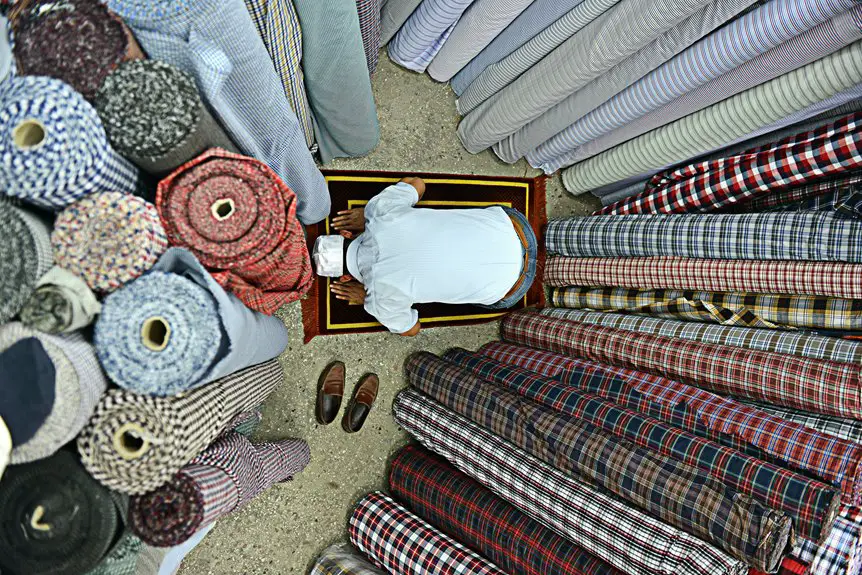You might have noticed how a “breathable polyester” jacket promises fresh air but leaves you feeling clammy after a hike. It’s like a window that claims to open but barely cracks. Polyester’s reputation for breathability is often more about clever marketing than actual airflow. Before you invest in your next workout gear or outerwear, it’s worth unpacking what those claims really mean—and what they don’t.
Table of Contents
Key Takeaways
- “Breathable polyester” often means loosely woven fabric, not true airflow or moisture exchange like natural fibers provide.
- Polyester’s moisture-wicking repels water, enabling quick drying but can trap heat and sweat, reducing comfort in hot conditions.
- Advanced fiber technology, such as microfiber and hollow fibers, enhances airflow but does not fully replicate natural fiber breathability.
- Marketing terms like “moisture-wicking” and “quick-dry” highlight improved drying speed, not inherent breathability or comfort improvements.
- Effective breathability in polyester relies on fabric weight, weave, and moisture control, with activewear prioritizing sweat management over casual uses.
Understanding Breathability in Fabrics
Although breathability might seem straightforward, it actually involves several factors that affect how fabrics handle moisture and air flow.
When you wear a garment, fabric moisture plays an essential role in comfort, as it determines how sweat moves away from your skin. You need materials that efficiently transport this moisture to the surface, where it can evaporate.
Airflow dynamics also influence breathability by allowing air to circulate through the fabric, helping to cool your body. Without proper airflow, moisture can build up, making you feel clammy and uncomfortable.
Proper airflow through fabric cools your body and prevents moisture buildup for lasting comfort.
Understanding these elements helps you see why breathability isn’t just about letting air pass through but also about managing moisture effectively to maintain comfort during various activities.
Polyester Fabric: Composition and Common Uses
Polyester is a synthetic fiber made from petrochemicals, prized for its durability and resistance to wrinkles and shrinking. When you choose polyester, you tap into fabric durability that suits many needs.
Understanding polyester types helps you pick the right one for your project. Here’s what you should know:
- Standard Polyester: Common in clothing and home textiles, it offers strength and easy care.
- Microfiber Polyester: Finer fibers create soft, lightweight fabrics, popular in activewear.
- Recycled Polyester: Made from plastic bottles, it combines sustainability with durability.
- Blended Polyester: Mixed with cotton or wool to enhance performance and comfort.
Knowing these types lets you appreciate polyester’s versatility without being misled by “breathable” claims.
How Polyester Compares to Natural Fibers in Breathability
Understanding the different types of polyester helps, but you might wonder how this synthetic fiber stacks up against natural ones when it comes to breathability.
Natural fibers like cotton, linen, and wool generally excel at allowing air to flow through, keeping you cooler and wicking moisture away from your skin.
Polyester benefits include durability, moisture resistance, and quick drying, but traditionally, it doesn’t breathe as well as natural fibers. You might find polyester traps heat and sweat more, which can feel uncomfortable during intense activities or hot weather.
Polyester offers durability and quick drying but tends to trap heat and sweat compared to natural fibers.
However, its ability to wick moisture and dry fast can offset some breathability drawbacks.
Ultimately, if breathability is your top priority, natural fibers often outperform polyester, but polyester offers practical advantages that natural fibers can’t always match.
The Role of Fiber Technology in Enhancing Airflow
When you look beyond the basic polyester fiber, advanced technologies play an essential role in improving airflow and comfort.
These innovations focus on altering the fiber structure to optimize airflow dynamics, making polyester more breathable than its traditional form.
Here’s how fiber technology enhances airflow:
- Microfiber Engineering: Producing ultra-fine fibers increases surface area, allowing better air passage.
- Hollow Fibers: Creating channels inside fibers promotes internal ventilation.
- Surface Treatments: Applying coatings that wick moisture away boosts evaporation and airflow.
- Fiber Cross-Section Design: Shaping fibers to maximize gaps improves breathability by facilitating air circulation.
Marketing Claims Behind “Breathable Polyester” Explained
You’ve probably seen terms like “moisture-wicking” and “airflow technology” slapped on polyester products, but what do they really mean?
Marketers often stretch the science to make fabrics sound more breathable than they are.
Let’s break down how much of these claims hold up under scrutiny.
Common Marketing Buzzwords
Although breathable polyester sounds impressive, many marketing terms used to describe it can be misleading. When you shop, it’s essential to boost your consumer awareness and look beyond catchy phrases. Marketers often use buzzwords to make sustainable fabrics seem more advanced than they really are.
Here are four common marketing buzzwords you’ll encounter:
- Moisture-wicking – Sounds great, but most polyester naturally repels water rather than truly absorbing and releasing sweat.
- Quick-dry – Polyester dries faster than cotton, but this isn’t unique or groundbreaking technology.
- Eco-friendly – Sometimes used loosely; check if recycled content or sustainable practices back this claim.
- Breathable – Often means loosely woven or treated fabric, not necessarily true air exchange.
Don’t let these phrases fool you—understand what’s behind the hype before buying.
Science vs. Advertising
Since breathable polyester often carries bold marketing claims, it’s important to separate scientific facts from advertising spin.
When you hear about “breathability” in polyester, understand that true science communication demands clear evidence—not just catchy slogans. Many brands stretch the truth, implying their fabrics perform like natural fibers without moisture buildup.
But advertising ethics require honesty; misleading claims can confuse you and distort expectations. The science behind polyester’s moisture management is real but limited—polyester can wick moisture but doesn’t breathe like cotton or wool.
As a consumer, you should question exaggerated promises and look for independent testing or peer-reviewed studies. Staying informed helps you avoid falling for hype and makes your choices smarter, grounded in reliable science rather than clever marketing.
Innovations Driving Polyester’s Moisture Management
You’ll find that microfiber and hollow fibers play a big role in moving moisture away from your skin.
Surface treatment technologies add another layer of sweat control by changing how fabric interacts with water.
Plus, multilayer fabric systems combine these innovations to boost overall breathability and comfort.
Microfiber and Hollow Fibers
When you look closer at polyester’s ability to manage moisture, microfiber and hollow fibers stand out as key innovations.
These specialized fibers enhance moisture control in ways traditional polyester can’t match.
- Microfiber advantages include a larger surface area, which improves moisture absorption and quick drying.
- Hollow fiber applications create tiny channels within the fiber, boosting ventilation and moisture wicking.
- Together, they reduce the feeling of dampness by speeding up sweat evaporation.
- These technologies make polyester fabrics more comfortable during intense activity or hot weather.
Surface Treatments Technology
Surface treatments play an essential role in enhancing polyester’s moisture management beyond its fiber structure.
When you apply advanced surface treatments, you alter the fabric’s interaction with water, enabling quicker moisture wicking and improved evaporation. These fabric finishes create a microscopic texture that helps pull sweat away from your skin, making you feel drier during activity.
You’ll find that some surface treatments add hydrophilic properties, attracting moisture to the fabric’s outer layer, where it can evaporate faster. Others use chemical coatings to reduce water absorption, keeping the fabric lightweight and breathable.
By focusing on surface treatments, manufacturers can enhance polyester’s performance without changing its inherent properties.
Multilayer Fabric Systems
Although polyester’s fiber and surface treatments influence moisture management, multilayer fabric systems take performance to the next level.
You’ll find that fabric layering leverages different materials to optimize moisture wicking, breathability, and comfort.
Here are four multilayer advantages you should know:
- Enhanced moisture transfer: Inner layers pull sweat away from your skin, while outer layers release it to the environment.
- Improved insulation: Layers trap air, regulating temperature without sacrificing breathability.
- Durability boost: Combining fabrics strengthens resistance to wear and tear.
- Versatility: Multilayer designs adapt to various activities and weather conditions.
Choosing the Right Polyester Fabric for Your Needs
How do you pick the right polyester fabric among so many options? Start by considering fabric weight—it directly impacts comfort and durability.
Lightweight polyester feels breezy but may lack robustness, while heavier fabric offers more protection but less airflow.
Next, think about moisture control. If you need fabric for activewear, prioritize polyester designed to wick sweat away from your skin, keeping you dry and comfortable.
For casual wear, breathability might be less critical, so fabric weight and texture could take precedence.
Also, check the fabric’s weave and any added finishes that enhance moisture management.
Frequently Asked Questions
How Does Washing Affect Polyester Fabric Breathability Over Time?
Ever wonder how washing frequency impacts polyester breathability? You’ll find repeated washing can reduce fabric durability, causing fibers to clog and limit airflow. So, you’ll want to balance cleanliness with preserving breathability over time.
Can Breathable Polyester Fabrics Cause Skin Irritation or Allergies?
You might experience skin sensitivity or allergy triggers from breathable polyester fabrics, especially if you have sensitive skin. Choosing hypoallergenic options and washing new garments before wearing can help reduce irritation risks effectively.
Are There Environmental Impacts of Producing Breathable Polyester Fabrics?
You should know that breathable polyester’s environmental impact depends on sustainable sourcing and manufacturing processes. If these aren’t prioritized, production can harm ecosystems, waste resources, and increase pollution, so choose brands focusing on eco-friendly practices.
How Do Breathable Polyester Fabrics Perform in Extreme Cold Weather?
You’ll find breathable polyester’s cold weather performance decent but limited; it offers some insulation capabilities but isn’t as warm as natural fibers. Layering is key to stay comfortable and effectively trap heat in extreme cold.
What Care Instructions Best Preserve Polyester’S Moisture-Wicking Properties?
Like handling a delicate flower, you should wash polyester in cold water to avoid moisture retention, skip fabric softeners, and air dry it gently. This keeps the moisture-wicking effective and boosts your fabric’s longevity.
- Tetron Fabric for Marine Applications: Durability and Use Cases - June 18, 2025
- Tetron Fabric for Outdoor Furniture: Weather Resistance and Care - June 18, 2025
- Tetron Fabric for Wall Coverings: Style and Application Tips - June 18, 2025





